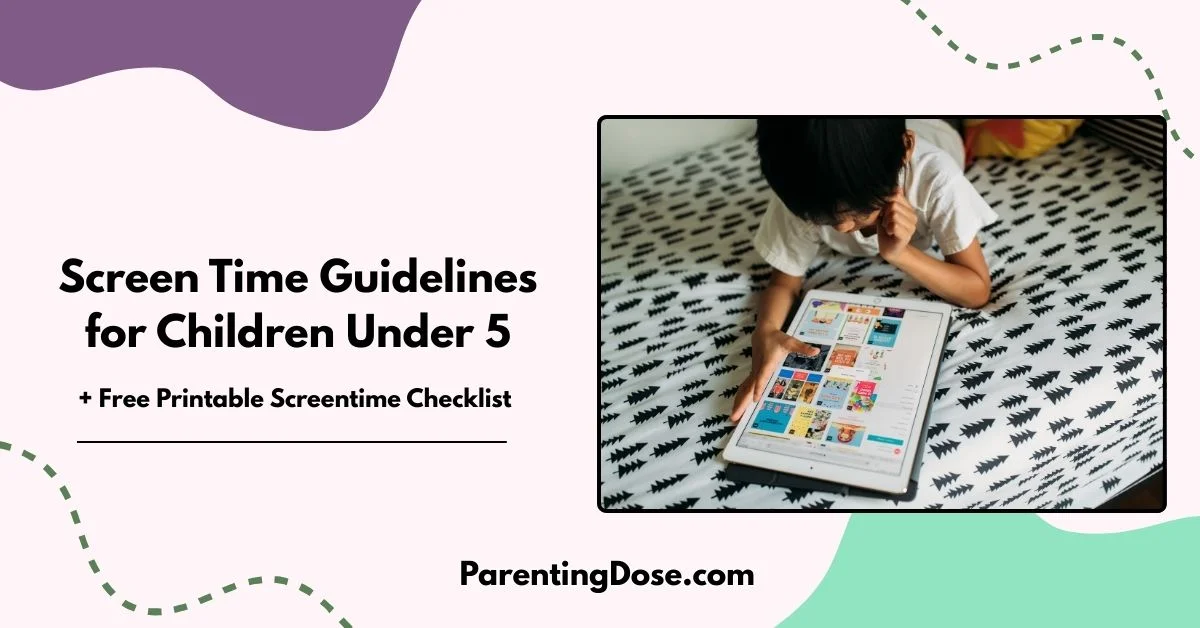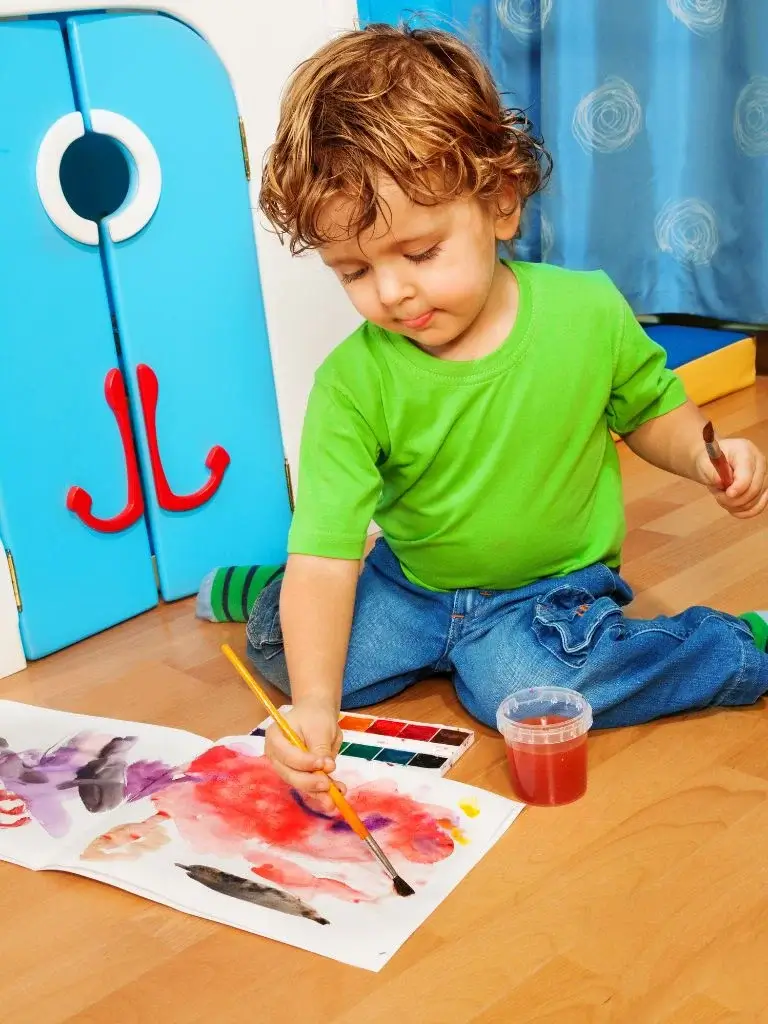It happened again. My toddler was mid-meltdown because I turned off the tablet. Breakfast was cold, toys were untouched, and my mom-guilt was at an all-time high.
If you’ve ever found yourself bribing your kid with one more episode just so you can shower in peace, you’re not alone.
Screens are part of modern parenting, but if you’re anything like me — a mom trying her best to raise emotionally connected, healthy kids — you’ve probably wondered: Is this too much? And more importantly, how do I cut back without turning every day into a battlefield?
How Screen Time Can Harm Children Under 5
No judgment here — I’ve relied on YouTube Kids and Daniel Tiger more times than I can count. But the truth is, excessive screen time can affect young children in ways we may not always see right away:
- Delayed language development: Screens don’t offer the same back-and-forth conversation that builds vocabulary and social skills.
- Disrupted sleep: Blue light from screens, especially before bed, can interfere with melatonin production and natural sleep rhythms.
- Shortened attention spans: Fast-paced content trains little brains to expect constant stimulation.
- Emotional regulation challenges: Kids who rely on screens to self-soothe may struggle more with managing big feelings.
- Less physical activity: Time spent sitting with a device can replace active, imaginative play essential for motor and cognitive development.
Think of screen time like sugar — okay in moderation, but not something we want on tap all day long.
Screen Time Guidelines for Children Under 5
The big question: How much is too much? Here’s a breakdown:
The World Health Organization (WHO) lays it out like this:
- Infants (under 1 year): No screen time at all.
- 1 to 2 years old: Avoid screen time. If introduced, it should be minimal and supervised.
- 2 to 4 years old: No more than 1 hour per day — and less is better.
Remember, quality matters. A 20-minute interactive video co-watched with a parent is far better than 60 minutes of passive viewing.
How to Reduce Screen Time for Kids Without Power Struggles
Setting limits sounds great on paper until you’re staring down a tantrum. Here’s what’s helped me (and my mom-friends who’ve been there too):
- Start with empathy, not punishment
“I know you love your show — it’s really fun! But now it’s time to play outside.” Validation helps your child feel heard, not scolded. - Create a visual schedule
Use simple pictures to show your child what to expect. Knowing what comes next builds trust and reduces resistance. - Use timers and transitions
Give a 5-minute warning and let a kitchen timer (or a visual timer) do the heavy lifting. It helps shift the blame from you to the routine. - Be consistent — but flexible
Hold the boundary with love. “We watch one show after snack — not more.” But if grandma’s visiting or someone’s sick? It’s okay to bend. - Model screen boundaries yourself
Yep, this one stings. But when our kids see us putting down our phones, they’re more likely to do the same.
Download Your Free Printable Screen Time Routine Chart!
I know how tough it can be to even start looking for the “perfect” screen time routine chart—so I created one for you.
💛 [Download your free printable screen time guidelines checklist for children under 5] — thoughtfully designed with soothing colors, simple icons, and just the right balance of structure for toddlers and preschoolers.
What to Replace Screen Time With (That Actually Keeps Kids Busy)
These are screen-free go-tos that have saved my sanity:
1. Sensory Play
Think water bins with measuring cups, homemade playdough with cookie cutters, or a tray of rice with hidden toy animals. These kinds of activities feel like play, but they’re secretly working overtime: developing fine motor skills, boosting concentration, and even calming big feelings.
Mom tip: Keep a “sensory shelf” stocked with rotating bins. Add lavender to rice or use themed cookie cutters for holidays — easy wow-factor!
2. Outdoor Adventures
Nature is the original screen-free playground. It doesn’t have to be a national park — your front porch, a patch of grass, or the sidewalk after rain can do the trick. Try:
- Bug hunts (with magnifying glasses!)
- Sidewalk chalk obstacle courses
- “Can you find something red?” scavenger games
Truth bomb: They don’t need a Pinterest-perfect backyard — just permission to explore.
3. Imaginative Play
This is where the magic happens. A cardboard box becomes a spaceship. A laundry basket? Pirate ship. Give them props and loose parts, then step back and watch their worlds unfold.
Ideas to spark play:
- Set up a “doctor’s office” for stuffed animals
- Rotate costumes or accessories weekly
- Create a mini kitchen with old utensils and dry pasta
Bonus: Imaginative play builds emotional intelligence, storytelling skills, and problem-solving — all without a screen in sight.
4. Art + Crafts
You don’t need to be “crafty” — you just need to provide the materials. A little mess is a small price for the quiet concentration (and independent play!) that art can bring.
Stock your craft cart with:
- Washable markers, glue sticks, construction paper
- Stickers, googly eyes, and stamps
- Watercolor paints and oversized brushes
Hot tip: Use a plastic tablecloth on the floor and let them go wild. Set up, walk away, sip coffee.
5. Books, Books, Books
Books can transport kids in the same way screens do — just more slowly, intentionally, and with space for their imaginations to do the heavy lifting.
- Rotate a small selection of books weekly to keep it fresh
- Create a cozy corner with pillows and soft lighting
- Try audiobook storytime during rest or quiet play
Pro tip: Toddlers love repetition. Reading the same book five times in a row? Totally normal — and developmentally powerful.
6. Simple Household Jobs
Letting kids “help” with real tasks gives them a sense of purpose and inclusion. It slows you down, yes, but it fills their tanks in ways screens never could.
Let them:
- Stir pancake batter or wash veggies
- Match socks or fold kitchen towels
- Use a spray bottle to “clean” windows or toys
Narrate what they’re doing (“You’re folding just like me!”) to boost connection and language development.
Pro Parenting Tip:
Offer two or three options instead of one.
Instead of saying, “Do you want to play outside?” (which often invites a hard no), try:
“Would you like to go outside and stomp puddles or do a water bin inside?”
It gives kids a feeling of autonomy — which dramatically reduces resistance.
Final Thoughts: You’re Doing Better Than You Think
Reducing screen time doesn’t mean aiming for perfection. It’s about creating a rhythm that supports your child’s growth and respects your own limits as a parent.
Some days you’ll crush it with nature walks and sensory bins. Other days, you’ll hand over the iPad and breathe. Both kinds of days are okay.
Remember:
- You’re not a bad mom for using screens.
- You’re a great mom for caring about balance.
- Your efforts — even the imperfect ones — matter.
Screens aren’t the enemy. They’re a tool. And when used with love, limits, and intention, they don’t have to rule your home






